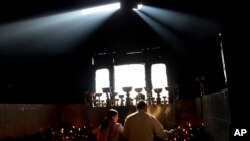Aid deliveries continued Tuesday in Nepal, where some outlying areas remained difficult to reach more than a week after a massive earthquake shook the Himalayan nation.
With crews digging through collapsed buildings and the remnants of landslides, the government said a total of more than 7,500 people had died as a result of the April 25 quake with another 14,500 injured.
The United Nations says 8 million people - more than one quarter of Nepal's population - have been affected by the disaster.
That number includes nearly 2 million children, and UNICEF said Monday a plane delivered 40 metric tons of aid as part of an effort to provide clean water and prevent any outbreak of water-borne diseases.
European officials say just 60 EU citizens remain unaccounted for, down from the 1,000 estimated by an official last week.
On Sunday, police said a 101-year-old man was found about 80 kilometers northwest of the capital, while rescue workers found three other survivors buried in debris in the northeast.
US aids relief effort
U.S. military aircraft, including four tilt-rotor Ospreys, heavy equipment and air traffic controllers arrived in Nepal Sunday, hoping to give relief operations a much-needed shot in the arm and reach more difficult areas that have received little aid since the April 25 quake.
The U.S. will help manage the growing piles of relief supplies clogging Nepal's only international airport in Kathmandu, which is struggling to distribute the aid arriving from around the world since the 7.8-magnitude quake.
The U.S. forces will "have multiple aims. They'll be delivering relief supplies, they might do some rescues, they'll also do assessments," U.S. Ambassador to Nepal Peter Bodde told the French news agency AFP.
"They're going to make an immediate difference," U.S. Brigadier General Paul Kennedy added.
"We've got relief supplies, especially shelter. Most people don't understand that shelter is the most pressing need," Kennedy said. "So we're going to take those things out starting tomorrow [Monday] morning. So for the people that have been affected by this earthquake, it's going to make an immediate impact on their lives."
Reach remote areas
Suraya Prasad Silwal, the home ministry secretary, said the U.S. aircraft would also airlift victims out of remote areas that suffered some of the worst devastation following the quake.
The United Nations also said it is looking at a wider array of options for getting supplies to people in the most remote areas, including transporting provisions on the ground through India.
"We are still having problems getting things to people," said Orla Fagan, a spokeswoman for the U.N. Office for the Coordination of Humanitarian Affairs. "There are people in very, very remote mountain villages."
But officials said nine days after the quake, hopes of finding more survivors are fast fading and the death toll could climb "much higher" than the current. Thousands of people are still missing.
The World Food Program vowed to expand efforts to get help to those in need.
"We were in communities today that we weren't in yesterday and tomorrow we will also deliver to communities that we didn't deliver to today. And we will continue at that pace, increasing that pace, escalating the number of people that we achieve, until no person who was affected by this earthquake is hungry," Executive Director Ertharin Cousin said.
The United Nations said more than 8 million people have been affected by the earthquake and at least 2 million have been displaced.
The International Committee of the Red Cross has created a website for friends and family to report missing loved ones or search for those who have checked in.
Some material for this report came from Reuters.










